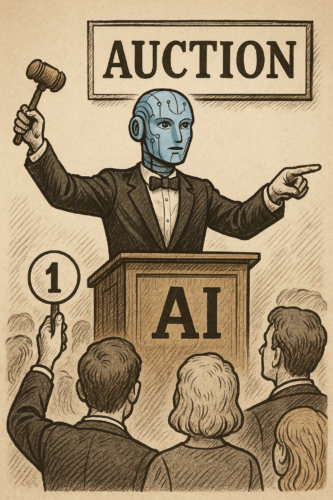
How AI is Revolutionizing Paid Search Advertising
The emergence of AI has shifted the paid marketing landscape in several ways – from automated “smart bidding” strategies to dynamically or even automatically created
In a week of rapid AI evolution, marketing leaders saw tech giants push boundaries and practitioners unlock new creative tactics. OpenAI’s latest model is stabilizing post-launch, while Google unleashed a wave of next-gen AI at its annual cloud summit. Businesses from B2B to e-commerce to home services are harnessing AI in novel ways, proving that automation and imagination can go hand in hand. Meanwhile, the rules of engagement are shifting from who can crawl your content to how teams balance AI with human touch. This upgraded weekly roundup connects each development to actionable marketing strategy.
After August’s launch, users found GPT-5 stiff compared to GPT-4o. OpenAI restored GPT-4o, added tuning controls, and promised a warmer default. GPT-5’s Thinking mode with 400k tokens is proving useful for deep analysis, making it a strong option for research and strategy work, while GPT-4o remains better suited for customer-facing copy where tone and empathy matter.
At Cloud Next, Google unveiled Gemini 2.5, a million-token multimodal model with specialized cousins: Imagen 3 for images, Chirp 3 for audio, Lyria for music, and Veo 2 for video. The standout was Gemini 2.5 Flash Image, code-named Nano Banana. Acting like Photoshop for everyone, it delivers background swaps, object removal, multi-turn edits, and consistent character identity, with all outputs watermarked. For marketers, this removes creative bottlenecks by letting teams generate dozens of ad-ready visuals in hours, test them rapidly, and scale winners without costly production cycles.
Google announced Gemini on Distributed Cloud for secure on-prem deployments. Meanwhile, Multiverse Computing unveiled compact models SuperFly and ChickBrain that outperform larger peers with quantum-inspired compression. This signals a split between massive cloud models for scale and nimble edge models for personalization at the point of interaction, giving marketers the flexibility to choose where they need reach versus intimacy.
OpenAI and Shopify are piloting chat-to-checkout flows. Instacart and others are following, with human approval layers to prevent misfires. This collapses the funnel into a single dialogue, forcing marketers to optimize product data for clarity and rethink conversion metrics for chat-driven sales.
Claude and GPT-based APIs now retain memory, enabling assistants that remember campaigns, brand guidelines, and customer histories. They act like junior strategists, delivering consistent on-brand content and context-aware support.
Meta’s voice dubbing translates Reels into the creator’s own voice. Google’s Veo 2 enables text-to-video. Nvidia’s Granary dataset powers multilingual training. Marketers can now stretch campaigns further without expanding budgets, with assets living in multiple languages and formats simultaneously.
MIT found 95 percent of AI projects deliver no measurable ROI. Marketers must tie AI experiments to outcomes they can track and be ready to cut what does not deliver.
AWS leaders warn against cutting junior staff. They adapt fastest to AI tools and become tomorrow’s leaders, which means AI works best when paired with human judgment.
Cloudflare now blocks AI crawlers by default and launched Pay Per Crawl. Brands must decide whether to allow visibility in AI answers or demand compensation, making content strategy an economic as well as editorial choice.
The US Defense Department approved its first generative AI system for secure use. Vendors are rushing to add indemnification and compliance features, which marketers can leverage as proof points of safety and trust.
| Initiative | Impact | Effort | First step |
|---|---|---|---|
| Measure traffic from AI assistants | High | Medium | Create referrer buckets for Bing Copilot, Perplexity, Gemini, ChatGPT. Add UTM presets, log assistant mentions in CRM, and report weekly "AI share of discovery". |
| Run Nano Banana creative sprints | High | Low | Generate 20 ad or social variants with Gemini 2.5 Flash Image. Ship a 48 hour test, promote top 3 winners, and archive losers for learning. |
| Pilot conversational commerce | High | Low | Launch a chat to checkout flow for one SKU or subscription. Track chat conversion rate, AOV, and abandonment versus your web flow. |
| Train the brand "voice coach" | Medium-High | Medium | Feed an assistant your style guide, top pages, and last 12 months of campaigns. Lock guardrails and require human QA on the first 10 outputs. |
| Publish multilingual versions of a top asset | Medium-High | Low | Auto dub or translate your best performing video or guide into two languages. Localize CTAs and retarget by region. |
| Build a first-party brand knowledge graph | High | Medium-High | Centralize facts, pricing, FAQs, and policies. Publish JSON-LD and an /answers sitemap. Wire the same corpus into your site chat. |
| Refactor three pages for answer readiness | Medium | Medium | Compress copy into concise summaries, add schema, FAQs, and source links. Validate with AI assistants for clarity. |
AI is no longer a side project. It is becoming the medium of modern marketing. Assistants are learning memory, visuals are one prompt away, and search is turning transactional. Marketers who act decisively now by experimenting, auditing, and scaling responsibly will define the playbook for years to come. The winners will be those who pair imagination with discipline and speed with trust.

The emergence of AI has shifted the paid marketing landscape in several ways – from automated “smart bidding” strategies to dynamically or even automatically created

While AI offers clear advantages, marketers should be mindful of challenges and limitations: Loss of Control and Transparency: One common concern is the “black box”

AI and machine learning in paid advertising has changed the landscape in so many ways, including streamlining processes and eliminating unnecessary manual tasks. That being